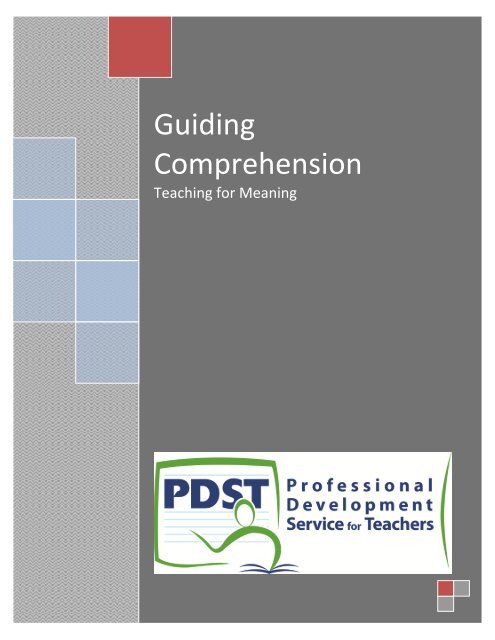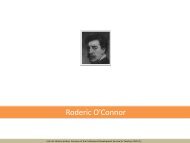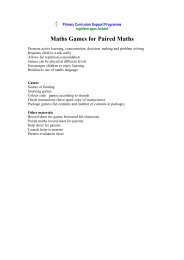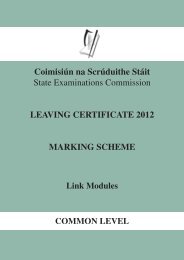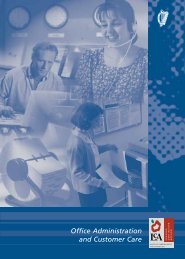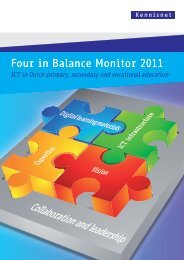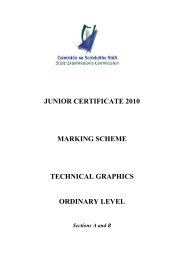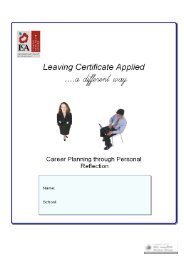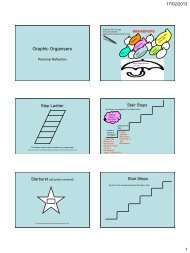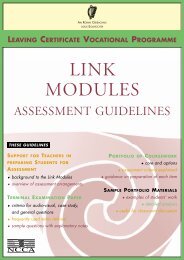Guiding Comprehension - PDST
Guiding Comprehension - PDST
Guiding Comprehension - PDST
You also want an ePaper? Increase the reach of your titles
YUMPU automatically turns print PDFs into web optimized ePapers that Google loves.
[Type text]<br />
<strong>Guiding</strong> <br />
<strong>Comprehension</strong> <br />
Teaching for Meaning
<strong>Guiding</strong> <strong>Comprehension</strong> – Teaching For Meaning <br />
“<strong>Comprehension</strong> is a process in which readers construct meaning by interacting with text <br />
through the combination of prior knowledge and previous experience, information in the text <br />
and the stance the reader takes in relationship to the text” <br />
Pardo, 2004 <br />
The teaching of reading needs to include a range of comprehension strategies. <br />
<strong>Comprehension</strong> strategies can be defined as the “mental processes” that good readers use <br />
to understand text. <strong>Comprehension</strong> strategies need to be explicitly taught.<br />
The diagram below illustrates the 3 levels of comprehension, ranging from the lower order <br />
literal type to the higher order evaluative type. <br />
Evaluative Synthesising<br />
Determining Importance<br />
Summarising and Paraphrasing<br />
Self Questioning<br />
Strategy Definitions and Activities to Support <br />
Inferential<br />
Connecting<br />
Comparing<br />
Inferring<br />
Predicting<br />
Literal<br />
Creating Images<br />
Skimming<br />
Scanning<br />
Self Questioning
Reading Strategies <br />
Definitions and activities to support implementation <br />
( denotes task card template located at end of resource book) <br />
Creating Images <br />
Readers create images using the senses to help them to draw <br />
conclusions, make predictions, interpret information, remember <br />
details and assist with overall comprehension <br />
Activities for Creating Images <br />
Picture This: Teacher reads a section of a text without showing any <br />
illustrations and children draw a visual representation of their <br />
interpretation of character/ setting/ event from that piece of text. <br />
Sensory Chart: Pairs of children select section of text and record pictorially <br />
or using key words what text looks like/ feels like/sounds like. <br />
Post Your Senses: Pupils record brief details on post it notes based on <br />
images they form as they read text. They stick the post it notes onto the <br />
appropriate part of the text. <br />
Changing Images: Teacher reads a section of a text without showing any <br />
illustrations. Teacher stops reading at a selected place in the text and asks <br />
children to sketch or write the mental image they have created. Children <br />
label this, Image 1-‐ My First Image. Teacher reads more of the text and <br />
children are given time to re-‐create their image based on the new <br />
information. Children label this, Image 2-‐ My Second Image. Children <br />
should be asked to discuss any changes made to the second image.
Open Mind Portrait: Children are asked to create character portraits and <br />
include key words to describe the character’s thoughts and feelings. <br />
Information Images: Children create key images based on informational <br />
text i.e. in a science or nonfiction book. <br />
Self questioning <br />
Self-‐Questioning encourages readers to constantly think of <br />
questions before, during and after reading to assist them to <br />
comprehend text. Self-‐formulated questions provide a <br />
framework for active reading and engagement as students go in <br />
search of the answers. <br />
Activities for Self Questioning <br />
Clouds of wonder: Pupils discuss text and generate “I wonder” questions <br />
represented on cloud shapes on a sheet. This can be done at regular <br />
intervals throughout the reading of a text. <br />
Stop and Think Cards: Children are given prompt cards with questions <br />
directing them to reflect on their understanding of section of text. i.e. Do I <br />
understand what that part was about Could I explain that part to <br />
somebody else <br />
Before, During, After Question Sheets: Children compose and record <br />
questions in 3 separate columns on a sheet: Before Reading, During <br />
Reading, After Reading. <br />
Written Conversation: Pairs of children exchange their thoughts and <br />
explanations of events in a text with each other in written form-‐ no talking <br />
allowed.
Skimming <br />
This involves glancing quickly through a text to gain a general <br />
impression of the content. Graphics, italics and headings are <br />
useful cues when skimming a text. <br />
Activities for Skimming <br />
Picture Flick: Children are given an opportunity to flick through illustrations <br />
to get an initial sense of the contents, characters and settings. They make <br />
predictions based on this quick glance at the text. <br />
Graphic Overlays: Pupils overlay text with tracing paper/ acetate, and <br />
outline chunks of text/ graphs/ headings etc. These sections are labelled on <br />
the overlay. This helps with the gathering of information where text is <br />
presented in columns interspersed with graphs/ pictures. <br />
Sneak Preview: Pupils complete Sneak Preview sheet to gain information <br />
before they read the text fully. The sheet can have sections for cover, <br />
headings, illustrations, author etc. Children fill in brief details in each <br />
section based on a quick skim through the text. After reading the text the <br />
children should discuss how their sneak preview prepared them for the <br />
text.
Scanning <br />
Scanning involves glancing through material to locate specific <br />
details, such as names, dates, places or some particular content. <br />
Activities for Scanning <br />
Hunt the Text Challenge: A set of quiz cards are created with questions <br />
seeking specific information i.e. page number, date, heading, title etc. <br />
Teacher reads out questions and asks children to locate the information as <br />
quickly as they can. <br />
Beat the Buzzer: Pupils can devise questions as above and record these on <br />
cards. Teacher collects all questions and asks them to the entire class. <br />
Children giving answers must also locate the page number and/or <br />
paragraph in which the answer appears. <br />
Retrieval cards: In advance of reading the text the children get a list of <br />
headings from the teacher about a piece of text i.e. habitat, food, size. <br />
Children scan the text to get this information and make generalisations <br />
before reading the text fully. This works well for informational texts i.e. <br />
species of dinosaurs, animals that hibernate etc. <br />
Interesting Words Charts: Pupils skim text for new / interesting vocabulary. <br />
Teacher records words on Interesting Word Chart along with page and <br />
paragraph number. Children are asked to look for clues in the text that <br />
might help explain what the word means. They record this contextual clue <br />
beside the new word. They can also record their own interpretation of <br />
what it means. Finally they are asked to check the meaning in <br />
a dictionary/ thesaurus/ glossary.
Predicting <br />
Prediction helps readers to activate their prior knowledge about a <br />
topic, so they begin to combine what they know with the new <br />
material in the text. Predictions are based on clues in the text <br />
such as pictures, illustrations, subtitles and plot. <br />
Activities for Predicting <br />
Split Images: Students work in pairs. Child A describes and elaborates on <br />
illustrations in the text. Child B is not permitted to look. Child B looks at <br />
the next picture and builds on Child’s A description and prediction. The <br />
process of alternating predictions continues until text is completed. <br />
Personal Prediction: Children predict using title, author, cover page etc. <br />
Children are then given key words from the text and asked to refine their <br />
earlier predictions. <br />
Check the Text: Teacher hides text and shows only illustrations, diagrams, <br />
pictures. Children predict and create their own text to match the <br />
illustrations. <br />
Crystal Ball : Whole text has been read. Divide children into groups, each <br />
group is allocated a character from the text. Each group brainstorms <br />
information about their character, i.e. likes, dislies, interests, personality <br />
traits that were stated explicitly or implicitly in the text. Then each group <br />
predicts the future for their character based on evidence from the original <br />
text and shares with other groups. <br />
Think Sheets: Key headings and chapter titles are used to construct <br />
questions based on the text. Allow children to think/pair/share and suggest <br />
answers prior to reading and compare these after having read the text. <br />
True/False -‐ Statements about events in the story are recorded by children <br />
before reading the text. Children then compare the statements after <br />
reading for confirmation/ rejection.
Connecting <br />
Connecting allows readers to comprehend text by making strong <br />
connections between their prior knowledge and the new <br />
information presented in text. <br />
Activities for Connecting <br />
Connecting with the text: Children mark areas in the text with post it notes <br />
to show places in the text with which they have made a personal <br />
connection i.e. own experience, previous reading material, similar <br />
characters. <br />
Before and After Chart: Information is organised on a chart into 3 columns <br />
• What we know before reading the text <br />
• What we now know after reading the text <br />
• What other information we would like to find out <br />
Think and share: children list key events in the story on one side of a <br />
page/chart. Each child takes on a character from the text and considers <br />
how this character was feeling during each event. These thoughts are <br />
recorded on the right hand side opposite the particular event. <br />
Linking texts: After a number of texts are read, children are asked to list <br />
these and illustrate the commonalties between the texts by drawing in <br />
linking lines. The similarity is recorded on the linking line. <br />
What’s in a Text : A group of children are given a common text to read. <br />
Teacher provides a list of questions about the text which encourage <br />
children to make connections with other texts i.e . What other texts have <br />
you read that were fairytales What do you know about fairytales What <br />
kind of characters are found in fairytales
Comparing <br />
This strategy is closely linked to ‘Connecting’. When making <br />
connections to the text, self, other texts and the outside <br />
world, pupils also make comparisons. There is an emphasis <br />
on identifying similarities and differences. <br />
Activities for Comparing <br />
Venn Diagram: Children use 2 overlapping circles to record features that <br />
are unique to each text on each circle. Common features are recorded in <br />
the overlapping section. Features to be compared could include topics, <br />
characters, plots, facts etc. <br />
Just Like: Children compare characters with themselves, with similar <br />
characters in other texts (witch in various stories) or with people child <br />
knows e.g. Grandma. <br />
Double Entry Journal: Children record key events from the text on one side <br />
of a journal page and on the other they note down connections with real <br />
life events or other books. <br />
Inferring <br />
This strategy allows the reader to move beyond the literal text <br />
and make assumptions about what is not explicitly stated in the <br />
text. It can involve predictions, conclusions and interpretations <br />
that are neither confirmed nor rejected. <br />
Activities for Inferring <br />
Character Self Portrait: Child adopts role of character, and using sentence <br />
starters given by the teacher, they create a profile for that character using <br />
explicit and implicit cues from text i.e. I live in a ......, I like .....
Interviews: Children in pairs conduct interviews where one child takes on a <br />
character and the other composes questions to ask the character. Teachers <br />
should model the type of questions required – ones which will focus on <br />
finding out more about the character than is explicit in the text. <br />
Rating Scales: Children choose a character to rate. The characters traits are <br />
discussed and recorded. i.e. Rude, Cowardly, Kind. <br />
Using a simple rating scale: Very, Quite, Not at all, the children tick the <br />
appropriate rating. Children need to justify their rating with evidence from <br />
the text. <br />
This activity should be done at regular intervals throughout the text to <br />
record changes in characters behaviour etc. <br />
Report Card: Children prepare a report card for a character in the text <br />
based on a number of “subjects” i.e. cooking, making friends, helping out. <br />
Children decide on a grade to give the character for that trait and provide a <br />
supporting comment that shows engagement with the text. <br />
What’s my Point of View: Class identifies four or five key events from a <br />
text. In groups children adopt a character and discuss each of the key <br />
events through the perspective of their adopted character. Teacher re <br />
organises groups so that each character is represented in each group. Each <br />
character’s point of view gets heard in each group. <br />
Developing Dialogue: In pairs children each choose a character and one key <br />
event. The children compose a dialogue in relation to that event which <br />
encourages them to draw inferences about the characters. Dialogues are <br />
shared with the class and children discuss the various dialogues that were <br />
created.
Synthesising <br />
This strategy allows a reader to bring together information that <br />
may come from a variety of sources. It involves readers piecing <br />
information together, like putting together a jigsaw. <br />
Activities for Synthesising <br />
Turn on the Lights: While reading a piece of text, children are asked to <br />
make note of any point in the text where something is clarified or has <br />
helped increase their understanding. These points represent the AH HA! <br />
moments that all readers have during reading. <br />
Plot Profile: Having read the text thoroughly children are asked to list the <br />
main events in the story in sequence. Each event is then rated for its impact <br />
or excitement level in the story, say 1 to 10. Each event can be plotted <br />
along a horizontal axis and matched with its excitement level on the vertical <br />
axis. The points are joined up to form a trend of excitement levels in the <br />
story from beginning to end. <br />
Great Debate: Teacher presents the class with an open-‐ended statement <br />
related to topic/text read. In groups children formulate affirmative or <br />
negative responses to the statement and justify their position on the <br />
matter. Children should share and compare their standpoints towards <br />
eventually drawing conclusions. <br />
Synthesis Journal: Pupils gather information on selected topic from several <br />
sources i.e. various textbooks or reference books chronicling the same <br />
topic. Children record key information from each source to build up a <br />
comprehensive picture on a topic. This works particularly well for History <br />
when children need to view events from the perspectives of different <br />
authors or writers.
Determining importance <br />
This strategy encourages readers to constantly ask themselves <br />
what is important in a phrase, sentence, paragraph, chapter or <br />
whole text. <br />
Activities for Determining Importance <br />
What’s Your Story: Having read the text fully first, children record on a <br />
sheet key pieces of information from the text in categories i.e. Setting, <br />
Main characters, Events. If this is done for different texts, the sheets can be <br />
used to compare texts. <br />
Famous Five Key Word Search: Children are asked to identify five key <br />
words in a text. They record these on post it notes and call them VIPs-‐ Very <br />
Important Points. In small groups children compare their VIPs and provide <br />
justifications for choosing these words. <br />
Main Idea Pyramid: Having read a text the class brainstorm important facts <br />
and record these on post it notes. The notes are grouped into categories or <br />
topics and placed at the bottom of a 3 tiered pyramid. Each group of notes <br />
are consolidated to make a shared point and this is recorded in the next <br />
layer up of the pyramid. The idea is that finally one main message will be <br />
recorded at the top of the pyramid.
Summarising and paraphrasing <br />
Summarising is the ability to reduce a larger piece of text so the <br />
focus is on the most important elements in the text. The re-stating<br />
or re-‐writing of text into other words is referred to as <br />
paraphrasing. Summarising and paraphrasing involve using the <br />
key words and phrases to capture the main focus of the text. <br />
Activities for Summarising and Paraphrasing <br />
Oral Summaries: Taking one section of text at a time groups are asked to <br />
read silently and collectively generate a summary of text through discussion <br />
and substantiation. <br />
Reciprocal Retells: As above but in this activity children in small groups <br />
take a specific event each from the text. They each retell the main points of <br />
their chosen event. Child A begins with a summary of their event and <br />
passes the story onto Child B etc. The whole summary is then shared with <br />
the class. <br />
Main Idea Sort: Works well with information texts. Teacher records key <br />
words / phrases onto cards. Pupils then arrange these to create an outline <br />
of the text and re-‐tell in summary form. <br />
Newspaper Report: Familiarise pupils with organisation of newspaper <br />
article beforehand. Using a piece of text, children organise the information <br />
according to the newspaper format i.e. Headline, date and place, main <br />
happenings, conclusion. <br />
66 Words: Children are challenged to read a text and create a summary in <br />
66 words or less. The children are given a grid of 66 rectangles to record the <br />
summary-‐ one word per rectangle. This makes children more judicious <br />
about choosing words and encourages them to only use the main ones. <br />
Children compare their 66 word grid in groups and try to come to a group <br />
consensus about the final 66 words. When complete they should discuss <br />
why they included/omitted certain words.
How to teach <strong>Comprehension</strong> Strategies <br />
Pearson & Gallagher, 1984 <br />
Gills Questions – Planning for comprehension <br />
1. What do my students know about this topic<br />
2. What specific vocabulary or concepts do they need to understand<br />
before they can understand this passage<br />
3. How can I get my students interested in this topic<br />
4. What purpose can I provide for the reading<br />
5. What activities will help my students engage in this text<br />
6. Do parts of this text allow for purposeful repeated readings<br />
7. Is there potential for teaching word identification strategies in this<br />
text<br />
8. What strategies do my students need to learn<br />
9. What strategies can I demonstrate with this particular text
Reading with your child <br />
Top Ten Tips for Parents /Guardians <br />
Infants – 1 st Class 2 nd and 4 th Class 5 th and 6 th Class <br />
Reading <br />
1. Read to your child as <br />
often as you can. <br />
2. Talk about books / <br />
characters / plots. <br />
3. Enrol your child in the <br />
local library. <br />
4. Provide a good role <br />
model by reading <br />
yourself / other family <br />
members. <br />
5. Keep audio tapes of <br />
familiar stories to play <br />
in the car. <br />
6. Vary the type of <br />
books read – stories / <br />
poems / information. <br />
7. Accept your child’s <br />
efforts with praise. <br />
8. Concentrate on what <br />
he /she got right. <br />
9. Make reading <br />
together enjoyable. <br />
10. Take part in school <br />
based initiatives like <br />
‘Shared Reading’. <br />
Reading <br />
1. Continue to read to your <br />
child everyday. <br />
2. Read some of the books <br />
your child enjoys so you <br />
can discuss them with <br />
him/her. <br />
3. Encourage your child to <br />
read to younger <br />
brothers/ sisters. <br />
4. Ensure that your child <br />
knows that you value <br />
and enjoy reading <br />
yourself. <br />
5. Make sure there is a <br />
wide variety of reading <br />
material in your home – <br />
newspapers, magazines, <br />
information, cookery <br />
books etc. <br />
6. Enrol and encourage <br />
your child to visit the <br />
local library once a <br />
week... <br />
7. Discuss favourite <br />
authors. <br />
8. Encourage your child to <br />
read articles / headlines <br />
in newspapers. <br />
9. Encourage your child to <br />
guess unknown words. <br />
10. Take part in school <br />
based initiatives like <br />
‘Shared Reading ’ <br />
Reading <br />
1. Encourage your child to <br />
visit the local library as <br />
often as possible. <br />
2. Recognise and praise <br />
your child’s efforts in <br />
reading. <br />
3. Ensure your child has <br />
access to a wide range <br />
of reading material –<br />
newspapers, <br />
magazines, guides etc. <br />
4. Take an interest in <br />
different children’s <br />
authors. <br />
5. Discuss ideas and points <br />
of view proposed by <br />
newspaper articles etc. <br />
6. Provide a well lit study / <br />
reading area. <br />
7. Ensure that you value <br />
and enjoy reading <br />
yourself. <br />
8. Allow your child to <br />
choose his /her own <br />
reading material. <br />
9. Encourage your child to <br />
read for information – <br />
timetables / weather <br />
forecasts / menus <br />
10. Encourage your child to <br />
try and guess unknown <br />
words.
PREDICTION<br />
Thinking about what<br />
might happen in the<br />
story and looking at<br />
the clues in the text<br />
and pictures will<br />
help me understand<br />
what it is about!<br />
I think this story is<br />
about……<br />
I predict that ……<br />
will happen<br />
next………<br />
From what I<br />
know....I don’t<br />
think.....<br />
Helpful<br />
hints...<br />
That’s not what I<br />
thought would<br />
happen...<br />
SELF-<br />
QUESTIONING<br />
Asking questions<br />
helps me<br />
understand a text.<br />
Remember to ask<br />
questions before,<br />
during and after<br />
you read!<br />
I wonder...<br />
How could that<br />
be<br />
Why do you<br />
think<br />
Helpful<br />
hints...<br />
Who... What...<br />
Where... When...<br />
What did that<br />
mean<br />
CREATING<br />
IMAGES<br />
Making a picture<br />
in my head as I<br />
read can help me<br />
understand a text<br />
better!<br />
Helpful<br />
hints...<br />
When I read this I<br />
can see ……<br />
I can smell, hear,<br />
taste,<br />
touch………<br />
I can feel.....<br />
I can see the<br />
picture in my<br />
head...it looks<br />
like...
Creating Images<br />
Self-Questioning<br />
Prediction
MAKING<br />
CONNECTIONS<br />
Sometimes when I<br />
read I can make a<br />
connection to<br />
something I already<br />
know!<br />
Helpful<br />
hints...<br />
SKIMMING<br />
If I quickly flick<br />
through the text I<br />
can get an overall<br />
idea of what the<br />
text is about.<br />
Helpful<br />
hints...<br />
INFERRING<br />
Sometimes as I<br />
read I need to<br />
make inferences.<br />
When the author<br />
doesn’t answer my<br />
questions I must<br />
infer.<br />
Helpful<br />
hints...<br />
That reminds me of<br />
a time when……<br />
That reminds me of<br />
somebody……<br />
That reminds me of<br />
another book<br />
where……<br />
When I was young<br />
I remember...and<br />
this sounds very<br />
similar...<br />
By quickly<br />
flicking through<br />
the text I know<br />
that...<br />
I think this will be<br />
useful because I<br />
can see by the<br />
headings that it<br />
includes....<br />
Using these<br />
different clues I<br />
can infer that...<br />
After reading that<br />
text I think that...<br />
Maybe....<br />
It could mean<br />
that....<br />
Perhaps....
Inferring<br />
Skimming<br />
Making Connections
SUMMARISING<br />
When I summarise<br />
I can think about<br />
what I have read<br />
and then focus on<br />
the important<br />
elements<br />
Helpful<br />
hints...<br />
COMPARING<br />
When I am<br />
comparing I can<br />
look and see what<br />
is the same or<br />
different!<br />
Helpful<br />
hints...<br />
SYNTHESISING<br />
When I use all my<br />
strategies to<br />
combine what I<br />
know with new<br />
information to<br />
understand the text<br />
I am synthesising.<br />
Helpful<br />
hints...<br />
First, next,<br />
finally, then....<br />
I think the<br />
purpose of this<br />
text was to...<br />
I can think about<br />
the most<br />
important parts<br />
and retell them in<br />
my own words...<br />
I can compare<br />
characters,<br />
events, settings....<br />
If I make a<br />
connection I can<br />
compare it to<br />
something I know<br />
already...<br />
I know that this is<br />
the same....<br />
I know that this is<br />
different to....<br />
Now, I get it!<br />
This makes me<br />
think of...<br />
I learned that...<br />
I understand this<br />
because...<br />
Using all the<br />
strategies I know,<br />
I think this is<br />
about...<br />
So, this bit helps<br />
me understand...
Synthesising<br />
Comparing<br />
Summarising
MONITORING<br />
COMPREHENSION<br />
Helpful<br />
hints...<br />
I know how to use<br />
different ways to<br />
help me when I<br />
get stuck on what<br />
the meaning of a<br />
text is.<br />
Helpful<br />
hints...<br />
When I get stuck<br />
on a word or<br />
when I get<br />
confused I can:<br />
...use what I know<br />
to think about the<br />
word<br />
...reread<br />
...read on<br />
....use my<br />
questions and<br />
connections<br />
DETERMINING<br />
IMPORTANCE<br />
I can understand<br />
the main ideas of<br />
the text and what<br />
the author’s<br />
message is.<br />
Helpful<br />
hints...<br />
The text was<br />
mostly about...<br />
The important<br />
details were...<br />
I will underline<br />
the key words...<br />
I think .... and<br />
....are important<br />
SCANNING<br />
Scanning helps me<br />
find information in<br />
a text, such as<br />
contents,<br />
illustrations and<br />
index.<br />
Helpful<br />
hints...<br />
I look for<br />
information, like<br />
names and<br />
dates...<br />
By looking<br />
closely at the text<br />
I have discovered<br />
that...<br />
I can also look<br />
for headings<br />
and/or<br />
information that<br />
might be<br />
highlighted...
Scanning<br />
Determining Importance<br />
egy Demonstration Plan <br />
Monitoring<br />
<strong>Comprehension</strong>
Planning framework<br />
Strategy<br />
Objective/Learning Intention<br />
Language<br />
Integration<br />
Lesson Outline<br />
• Modelled <br />
• Shared <br />
• Guided <br />
• Independent <br />
Resources
Inferring<br />
I think that ……… he is thinking this<br />
because ……<br />
I think the character is …… because<br />
Scanning<br />
I scan for important information.<br />
If I am scanning for who I look for<br />
capital letters (names), if I scan for<br />
when I look for days (capital letters),<br />
dates, years, times (numbers)<br />
Creating Images<br />
When I read this I can see ……<br />
I can smell, hear, taste, touch………<br />
Determining Importance<br />
The main points are………<br />
This is really important because ………<br />
Who, What, When, Where, Why …
Predicting<br />
I think this story is about……<br />
I predict that …… will happen next………<br />
Connecting<br />
That reminds me of a time when……<br />
That reminds me of somebody……<br />
That reminds me of another book where……
<strong>Comprehension</strong> Strategy<br />
Task Sheets<br />
The following task cards can be<br />
used to consolidate strategies<br />
for children.
At A Glance<br />
Text: _____________<br />
Author: _____________<br />
Illustrator: ____________<br />
What I notice about the cover:<br />
______________________<br />
______________________<br />
______________________<br />
______________________<br />
______________________<br />
_____<br />
What I notice about the<br />
illustrations:<br />
_____________________<br />
_____________________<br />
_____________________<br />
_____________________<br />
_____________________<br />
____________________<br />
What I notice about the title and<br />
headings:<br />
______________________<br />
______________________<br />
______________________<br />
______________________<br />
______________________<br />
_______________<br />
What I notice about the<br />
author:<br />
____________________<br />
____________________<br />
____________________<br />
____________________<br />
____________________<br />
____________________<br />
_____<br />
Questions I have about the text:<br />
______________________<br />
______________________<br />
______________________<br />
______________________<br />
______________________
Text:<br />
Topic:<br />
Ideas from Text:<br />
Double Entry Journal<br />
Author:<br />
Connection or comparison:
Text:<br />
Topic:<br />
From the Text:<br />
(Quote)<br />
Double Entry Journal<br />
Page<br />
No.<br />
Author:<br />
Connection or<br />
comparison:<br />
(Questions; Connections;<br />
reactions; predictions......)
Text:<br />
Topic:<br />
Quotation:<br />
Double Entry Journal<br />
Page<br />
No.<br />
Author:<br />
Why I find this<br />
quotation interesting or<br />
important:
What a Story!<br />
Title: __________________<br />
Author: __________________<br />
Text Type and Topic <br />
Setting <br />
Events or Action <br />
Characters


